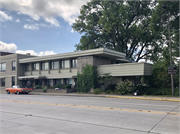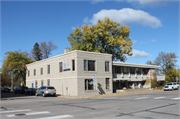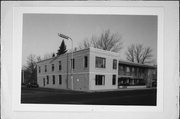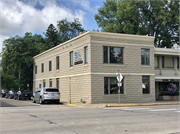Property Record
103 N KNOWLES AVE
Architecture and History Inventory
| Historic Name: | DOAR AND MCNALLY LAW OFFICE |
|---|---|
| Other Name: | DOAR DRILL AND SKOW TRIAL LAWYERS |
| Contributing: | Yes |
| Reference Number: | 47370 |
| Location (Address): | 103 N KNOWLES AVE |
|---|---|
| County: | St. Croix |
| City: | New Richmond |
| Township/Village: | |
| Unincorporated Community: | |
| Town: | |
| Range: | |
| Direction: | |
| Section: | |
| Quarter Section: | |
| Quarter/Quarter Section: |
| Year Built: | 1901 |
|---|---|
| Additions: | 1907 |
| Survey Date: | 19832018 |
| Historic Use: | small office building |
| Architectural Style: | Twentieth Century Commercial |
| Structural System: | |
| Wall Material: | Rock-Faced Concrete Block |
| Architect: | Michael Mcguire |
| Other Buildings On Site: | |
| Demolished?: | No |
| Demolished Date: |
| National/State Register Listing Name: | New Richmond Commercial Historic District |
|---|---|
| National Register Listing Date: | 12/22/2022 |
| State Register Listing Date: | 5/20/2022 |
| National Register Multiple Property Name: |
| Additional Information: | In 1883, William F. McNally and Frank Fuller established a law firm in New Richmond. McNally worked alone from 1886 and moved his office to a new building, located at 103 North Knowles Avenue, constructed as office space for the New Richmond Roller Mills business. For more information on the New Richmond Roller Mills, later known as Doughboy Industries, refer to the Industry Chapter. In 1908, William T. Doar joined McNally, and the office was renamed Doar and McNally. McNally died in 1923, leaving the firm to Doar. The New Richmond Roller Mills constructed a small addition on the rear of the concrete building in 1923. The milling company, renamed Doughboy in 1935, left the space in 1943. Warren P. Knowles joined the office in 1933, W.T. Doar, Jr. joined in 1947, and John Doar joined in 1950, all of them as partners. John Doar left in 1960, and Knowles left in 1964, both to pursue political careers. James Drill joined in 1966. The law firm expanded in 1977 with a large extension to the north and leased office space to other tenants. The Wrightian style law office extension was designed by architect Michael McGuire. The building is still partly occupied by the Doar, Drill, and Skow law firm, a direct descendant of the original law office. The 1907 and 1925 parts of the building are two stories with a flat roof and rectangular plan. A stone beltline is between the two stories. The exterior fabric is rock faced. A cornice has a stone cap and four other lines of stone running along it. Windows have stone sills. One on the south side has been filled in. The 1907 section is the part on the NW corner of North Knowles Avenue and West First Street. West of this is the 1925 addition of the same style. A two story wood and stone addition has been put on recently (1970's) to the north of the rock faced building. It has a flat roof and large windows. The building is in good condition. The back of it faces the Willow River. In spite of the addition and window changes this building has retained much of its original integrity. It is recognizable as an early 20th century structure. Frank Chapman was one of the early lawyers practicing in New Richmond. He came here after the Civil War. In 1873 he was admitted to the bar and in 18787-9 he was the first village attorney. Later he became village president (1880). He took on Frank Fuller as a law partner in the 1880's. When Chapman died in 1884, Fuller and William Francis McNally becmae partners (see residence SC 20-3, 112 South Dakota). By 1886 McNally was practing alone. Miles P. McNally soon joined him. In the late 1800's the McNally's and John E. Glover (see residence SC 20-19, 251 West Second Street) were partners in the New Richmond Roller Mills (see SC 31-8, 215 North Knowles Avenue). The mills were reorganized and incorporated as such asfter the 1899 tornado. They began to become a modern industry. This was especially so after a 1916 jfire caused the change from stone to steel rollers. In 1907 this building was put up to house the roller mills on one floor and the law offices on the others. W.T. Doar joined the fir5m in 1908 and when McNally died in 1923 he practiced alone. He was the Wisconsin Bar Association president in 1931. In 1933 W.P. Knowles joined his uncle's firm. From 1933-1964 the firm was Doar and Knowles. Knowles left to become the Governor in 1964. W.T. Doar, Jr. and John Doar joined the firm by 1950. The senior Doar died in 1952 and John left for government service. The roller mills, which are todawy Doboy and Domain, put on an addition in 1925. By 1943 they had outgrown the building and sold it to the law firm Dr. Armstrong (see residence SC 20/12, 367 W. 1st Street) occupied part of it for many years and an accounting firm now occupies part. Significance: The New Richmond roller mills (Doboy and Domain) have been a part of New Richmond since the 1860's. It was not until after the 1899 tornado that the mills began as a modern organization. At this point 6the mills were occupying this building. They have been a large part of the city. Because of the important roll the mills have played in the development of the community, especially betw3een 1901 and the second World War, this building has historical significance. Note: The New Richmond Roller Mills put up the building as office space for themselves on the first story and the law offices on the second. Bell and Webster Concrete supplied the concrete bricks/stones. It was built to be fireproof. |
|---|---|
| Bibliographic References: | New Richmond Walking Tour brochure, 2000. |
| Wisconsin Architecture and History Inventory, State Historic Preservation Office, Wisconsin Historical Society, Madison, Wisconsin |




